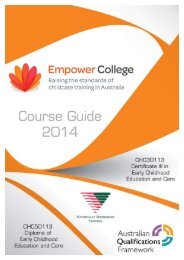Anaphylaxis Management Guidelines
You also want an ePaper? Increase the reach of your titles
YUMPU automatically turns print PDFs into web optimized ePapers that Google loves.
Definitions<br />
Adrenaline<br />
Adrenaline is a natural body hormone.<br />
Adrenaline is the only effective treatment<br />
for anaphylaxis. It works in minutes to relax<br />
breathing, maintain heart function and<br />
blood pressure.<br />
Adrenaline autoinjector (such as an<br />
EpiPen ® or Anapen ® )<br />
This is a device that automatically delivers<br />
a single fixed dose of adrenaline and is<br />
designed for use by people without specific<br />
medical training. 1<br />
Allergens<br />
Substances that can cause an allergic reaction. 1<br />
Allergy (or Allergies)<br />
Allergy is when the immune system reacts<br />
to substances (allergens) in the environment<br />
which are usually harmless such as<br />
food proteins, pollens, dust mites and<br />
insect venoms.<br />
<strong>Anaphylaxis</strong><br />
A severe, rapidly progressive allergic reaction<br />
that is potentially life threatening. As deaths<br />
have occurred as a result of anaphylaxis, it<br />
must be regarded as a medical emergency.<br />
Australasian Society for Clinical Immunology<br />
and Allergy (ASCIA) Action Plan<br />
Provides details on how to manage mild to<br />
moderate allergic reactions and anaphylaxis<br />
including appropriate medications, as well<br />
as listing known allergens. It is important<br />
that the ASCIA Action Plan is completed by<br />
a medical practitioner.<br />
Individual <strong>Anaphylaxis</strong> Health Care Plan<br />
A plan completed in consultation with<br />
parents/guardians detailing the child’s known<br />
allergens and risk minimisation strategies to<br />
be employed.<br />
Key principles<br />
The Government of Western Australia and all<br />
child care services are committed to:<br />
Providing, as far as practicable, a safe and<br />
supportive environment in which children at<br />
risk of anaphylaxis can participate equally in<br />
all aspects of the child care activities;<br />
Raising awareness about allergies and<br />
anaphylaxis in the child care community;<br />
4 <strong>Anaphylaxis</strong> <strong>Management</strong> <strong>Guidelines</strong>





